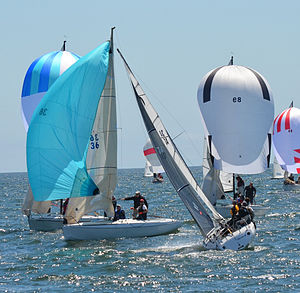
Left-hand boat: Down wind with stalled airfow— predominant drag component propels the boat with little heeling moment.
Right-hand boat: Up wind (close-hauled) with attached airflow—predominant lift component both propels the boat and contributes to heel.

A. Luffing (no propulsive force) — 0-30°
B. Close-Hauled (lift)— 30-50°
C. Beam Reach (lift)— 90°
D. Broad Reach (lift–drag)— ~135°
E. Running (drag)— 180°
True wind (VT) is the same everywhere in the diagram, whereas boat velocity (VB) and apparent wind (VA) vary with point of sail.
Forces on sails result from movement of air that interacts with sails and gives them motive power for sailing craft, including sailing ships, sailboats, windsurfers, ice boats, and sail-powered land vehicles. Similar principles in a rotating frame of reference apply to windmill sails and wind turbine blades, which are also wind-driven. They are differentiated from forces on wings, and propeller blades, the actions of which are not adjusted to the wind. Kites also power certain sailing craft, but do not employ a mast to support the airfoil and are beyond the scope of this article.
Forces on sails depend on wind speed and direction and the speed and direction of the craft. The direction that the craft is traveling with respect to the "true wind" (the wind direction and speed over the surface) is called the point of sail. The speed of the craft at a given point of sail contributes to the "apparent wind"—the wind speed and direction as measured on the moving craft. The apparent wind on the sail creates a total aerodynamic force, which may be resolved into drag—the force component in the direction of the apparent wind—and lift—the force component normal (90°) to the apparent wind. Depending on the alignment of the sail with the apparent wind, lift or drag may be the predominant propulsive component. Total aerodynamic force also resolves into a forward, propulsive, driving force—resisted by the medium through or over which the craft is passing (e.g. through water, air, or over ice, sand)—and a lateral force, resisted by the underwater foils, ice runners, or wheels of the sailing craft.
For apparent wind angles aligned with the entry point of the sail, the sail acts as an airfoil and lift is the predominant component of propulsion. For apparent wind angles behind the sail, lift diminishes and drag increases as the predominant component of propulsion. For a given true wind velocity over the surface, a sail can propel a craft to a higher speed, on points of sail when the entry point of the sail is aligned with the apparent wind, than it can with the entry point not aligned, because of a combination of the diminished force from airflow around the sail and the diminished apparent wind from the velocity of the craft. Because of limitations on speed through the water, displacement sailboats generally derive power from sails generating lift on points of sail that include close-hauled through broad reach (approximately 40° to 135° off the wind). Because of low friction over the surface and high speeds over the ice that create high apparent wind speeds for most points of sail, iceboats can derive power from lift further off the wind than displacement boats.
Various mathematical models address lift and drag by taking into account the density of air, coefficients of lift and drag that result from the shape and area of the sail, and the speed and direction of the apparent wind, among other factors. This knowledge is applied to the design of sails in such a manner that sailors can adjust sails to the strength and direction of the apparent wind in order to provide motive power to sailing craft.
© MMXXIII Rich X Search. We shall prevail. All rights reserved. Rich X Search
